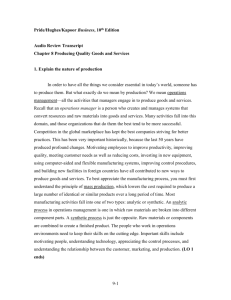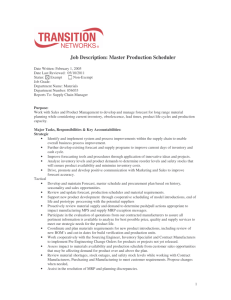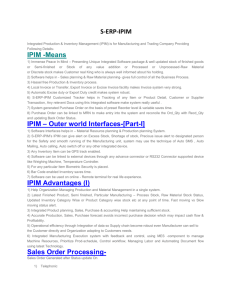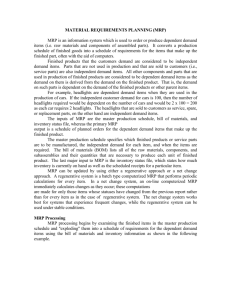Materials requirements planning (MRP) is a “pull
advertisement
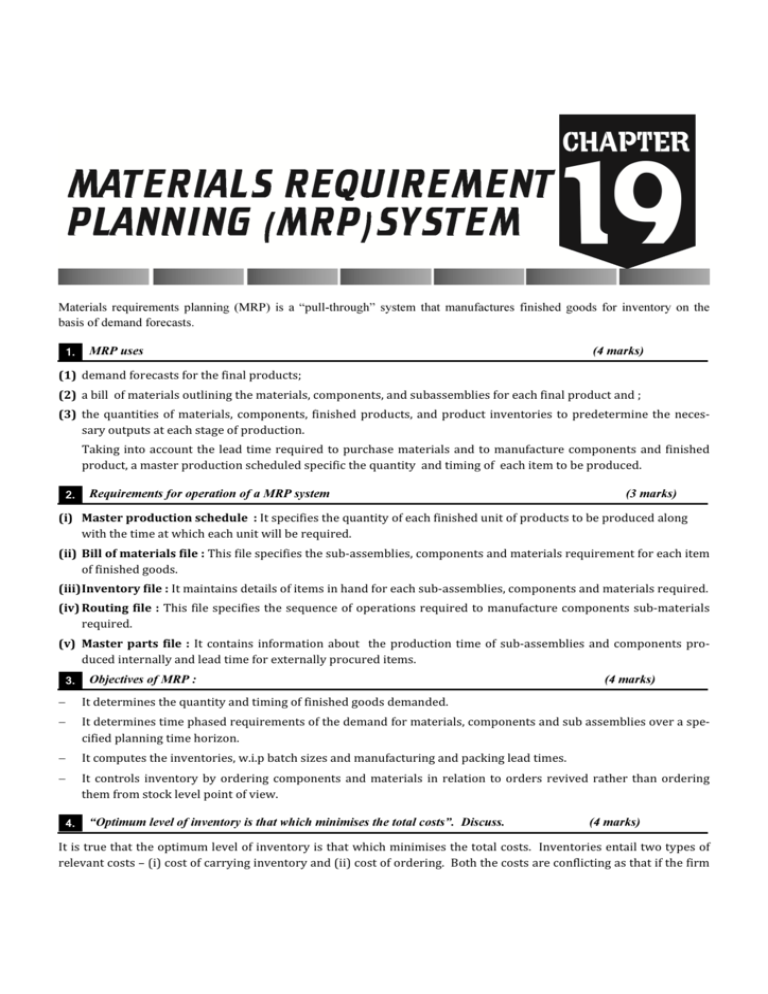
Materials requirements planning (MRP) is a “pull-through” system that manufactures finished goods for inventory on the basis of demand forecasts. 1. MRP uses (4 marks) (1) demand forecasts for the final products; (2) a bill of materials outlining the materials, components, and subassemblies for each final product and ; (3) the quantities of materials, components, finished products, and product inventories to predetermine the necessary outputs at each stage of production. Taking into account the lead time required to purchase materials and to manufacture components and finished product, a master production scheduled specific the quantity and timing of each item to be produced. 2. Requirements for operation of a MRP system (3 marks) (i) Master production schedule : It specifies the quantity of each finished unit of products to be produced along with the time at which each unit will be required. (ii) Bill of materials file : This file specifies the sub-assemblies, components and materials requirement for each item of finished goods. (iii) Inventory file : It maintains details of items in hand for each sub-assemblies, components and materials required. (iv) Routing file : This file specifies the sequence of operations required to manufacture components sub-materials required. (v) Master parts file : It contains information about the production time of sub-assemblies and components produced internally and lead time for externally procured items. 3. Objectives of MRP : (4 marks) − It determines the quantity and timing of finished goods demanded. − It determines time phased requirements of the demand for materials, components and sub assemblies over a specified planning time horizon. − It computes the inventories, w.i.p batch sizes and manufacturing and packing lead times. − It controls inventory by ordering components and materials in relation to orders revived rather than ordering them from stock level point of view. 4. “Optimum level of inventory is that which minimises the total costs”. Discuss. (4 marks) It is true that the optimum level of inventory is that which minimises the total costs. Inventories entail two types of relevant costs – (i) cost of carrying inventory and (ii) cost of ordering. Both the costs are conflicting as that if the firm 2 decides to have huge stock, the costs of carrying will increase and the costs of ordering will fall and vice versa. Therefore, these costs have to be balanced. Two key questions to have optimum level of inventory are: (i) What quantity should be purchased or manufactured. (ii) when should that quantity be purchased or manufactured. If EOQ and safety stock are well balanced that will minimise the total costs. 5. Mention few areas of material cost control. (4 marks) The potential areas for materials cost control may be considered under the following heads : Purchasing : Before purchasing various type of materials it is necessary to determine: What to purchase ? When to purchase ? How much to purchase ? From where to purchase ? At what price to purchase ? The price paid should be the minimum possible. Stock control : Its objective is to achieve maximum efficiency in production and sales with minimum investment in inventory. This objective may be achieved by resorting to inventory control techniques. Materials storage, issue and handling : There should be no overstocking of materials in order to minimize interest charges; godown charges, deterioration in quality and losses due to obsolescence. Issues of materials should be made on the basis of properly authorized requisition slips; usually it is the foreman of a department who has the authority to draws materials from the store. Issue must be made on the basis of FIFO method. Material should be handled properly in the store. Proper tools and equipment should be used for handling them so as to reduce wastage and losses. Mishandling of materials in stores will result in the increase of costs. Wastage : It should be minimum during the process of manufacture. 6. Mention the data required to operate the material requirement planning system. (4 marks) Data requirements to operate material requirement planning system: 1. 2. 3. 4. 5. 7. The master production schedule: This schedule specifies the quantity of each finished unit of products to be produced and the time at which each unit will be required. The Bill of material file: The bill of material file specifies the sub-assemblies, components and materials required for each of the finished goods. The inventory file: This file maintains details of items in hand for each sub-assembly, components and materials required for each of the finished goods. The routing file: This file specifies the sequence of operations required to manufacture sub-assemblies, components and finished goods. The master parts file: This file contains information on the production time of sub assembles; components produced internally and lead times for externally acquired items. Explain the pre-requisites for successful operation of material requirement planning. (5 Marks) Pre-requisites for successful operation of MRP system are: (i) The latest production and purchasing schedules prepared should be strictly adhered to Day to Day change from predetermined schedules will cause chaos. (ii) Raw Materials, sub-assemblies and components required for production should be pre-determined in quantifiable terms. Standard should be set for the consumption quantity, quality, mix and yield of raw materials for every unit of finished product. (iii) Work-force must be appraised of the system and the need for absolute adherence to the schedules prepared. (iv) Necessary internal control system should be developed to ensure total adherence to the schedule. 3 (v) Accuracy of the data supplied is vital to the MRP system. 8. Write a note on “Requirements Explosion”. The MRP system decides the demand for materials, components and sub assemblies at each stage of production. Once the scheduled production starts, the output of each department is pushed through the MRP system to the next department. From the data input, the MRP system knows: (i) What it is expected to produce (through the MPS file)? (ii) How it should produce it (through the BOM file)? and with (iii) What it has to produce it (through the inventory records file)? This programme starts with the finished goods demand (from the MRPs) and converts the demand requirements backward in time to schedule the desired production of the finished goods from raw materials and component parts with ‘time phased’ adjustments for lead time requirements. This process is called ‘Requirements Explosion’.



